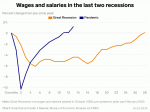 Noam Galai/Getty Images
Noam Galai/Getty Images
Various economic indicators are surpassing their pre-pandemic highs as stimulus and reopening drive the country toward a full recovery.
US wages are the latest to rebound.
Salaries and hourly wages finally leaped above their February 2020 peak in March 2021, according to the Bureau of Economic Analysis. Employee payment across the country rose to a seasonally adjusted annual rate of $9.78 trillion from $9.67 trillion, marking a new record high and an eleventh consecutive climb.
By comparison, it took more than twice as long for wages to fully rebound from their decline during the Great Recession.
The sharp increase seen two months ago was powered by stronger wage growth for low-skill workers. Those Americans have enjoyed a massive jump in wages from January to March as vaccines started to be rolled out and service jobs bounced back. Wage growth for medium- and high-skill workers remain below their pre-pandemic rates, albeit only slightly so.
The bounceback in low-wage income growth marks a positive development amid the largely uneven recovery. The white unemployment rate still sits significantly lower than that for Black and Asian Americans. And while wages are rebounding across racial and gender lines, the pandemic only exacerbated long-lasting inequalities.
More broadly, the labor market seemed to turn a corner in March. Payroll growth shot higher as stimulus and the easing of lockdown measures juiced the economic recovery. Gains were also strongest among leisure and hospitality businesses, some of the firms hit hardest by the virus and its fallout.
The labor market's rebound is expected to have accelerated last month. The Bureau of Labor Statistics is set to publish April payroll growth data on Friday and reveal how reopening and warmer weather benefitted hiring. The median estimate from economists surveyed by Bloomberg calls for nearly 1 million nonfarm payroll additions. They also expect the unemployment rate to drop to 5.8% from 6%.
Economists got their first preview of April job creation Wednesday morning. The country's private sector added 742,000 payrolls in April, according to ADP's monthly employment report. That missed the median estimate of 873,000 private payrolls but still marked a fourth straight monthly gain.
"Service providers have the most to gain as the economy reopens, recovers, and resumes normal activities and are leading job growth in April," Nela Richardson, chief economist at ADP, said.
NOW WATCH: Here's what it's like to travel during the coronavirus outbreak
See Also:

